|
Vetter 2011 Fuel Economy Challenge at Mid-Ohio Vintage Days - July 22, 2011 as reported by Kraig Schultz who rode an electric motorcycle in the event. |
|
July 22 - Vetter Fuel Economy Challenge A beautiful, hot morning. The group of 12 motorcycles (2 diesel, 3 electric and 6 gasoline) and 2 cars (1 diesel, 1 gas-electric hy-brid) left Mid-Ohio Racetrack prepared to ride out to see who could travel the route for the lowest cost per mile. 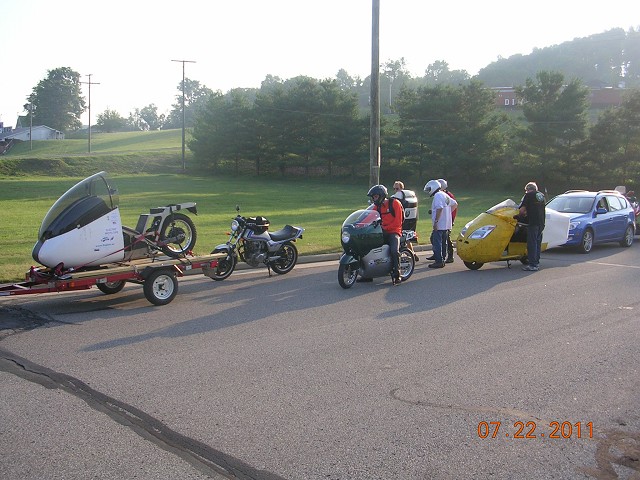 |
|
Un-Official Results - as of July 25 - 8am Watch Craig Vetter's site for official results. http://craigvetter.com/pages/2011-%20Fuel%20Economy%20Contests/2011-Mid-Ohio-results.html #1 Max Perethian on his NX250 consumed $2.47... ($.0237 per mile) 152.88 mpg #2 Fred Hayes HDT Diesel consumed $2.68 in bio Diesel... ($.0257 per mile) 143.53 mpg #3 Jack McCornack Diesel car consumed $3.14 Diesel... ($.0301 per mile) 127.38 mpg #4 Dale on Hayes HDT Diesel #2 consumed $3.23 in bio Diesel... ($.031 per mile) 119.22 mpg #5 Alan Smith, 250 Ninja consumed $3.27 in pump gas... ($.0314 per mile) 115.9 mpg #6 Craig Vetter, Honda 250 scooter $3.57 in pump gas...($.0343 per mile) 109.57 mpg #7 Ted Visscher F650 GS consumed $5.30 in pump gas... ($.0509 per mile) 73.64 mpg #8 Tim Yow KLR 650 consumed $5.62 in pump gas... ($.0539 per mile) 69.57 mpg #9 Charly Perethian Honda CB400T twin consumed $8.59 in pump gas... ($.0824 per mile) 45.47 mpg For the 38 miles from Mid-Ohio to Mt. Vernon (at 55mph), the electric bikes performed at the following levels (Assumptions: Wh/mile below are "wall to wheel", $.12/kWh electricity cost, and 80% recharge efficiency): John Harding, Riding 2010 Current Motor C130 Electric Scooter, Sitting Upright: 125Wh/mile, $.015/Mile Electricity Kyle Ginaven, 1989 Suzuki Katana conversion, Riding In Tucked Position: 110 Wh/mile, $.013/Mile Electricity Kraig Schultz, Riding 2011 Delta-11 prototype, Sitting Upright: estimated 95 Wh/mile, $.011/Mile Electricity Hy-Brid Electric: Jacob Melrose of Wooster Green Cars driving a Prius Hybrid with Enginer booster battery system on board: TBD |
|
Electric Motorcycles Travel 38 Miles at 55mph With Fossil Fuel Bikes Three electric motorcycles rode 38 miles with the fossil fuel bikes to the snack break in Mt. Vernon (speed was 55mph). This picture shows all the bikes lined up in Mt. Vernon at the first rest stop. 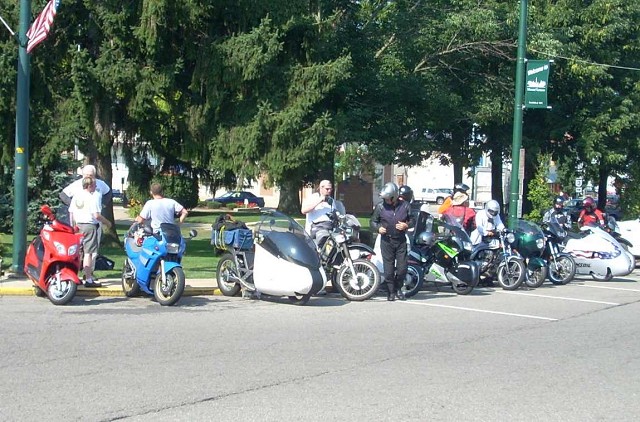 That's Luke Deptula from Enginer, with Kraig Schultz checking out cell voltage levels and motor temperature on the Delta-11 motorcycle after traveling 38 miles at 55mph. Everything checked out great. Luke was riding shotgun in a Prius Hybrid carrying the same size 8 kW pack as the Delta-11 motorcycle. 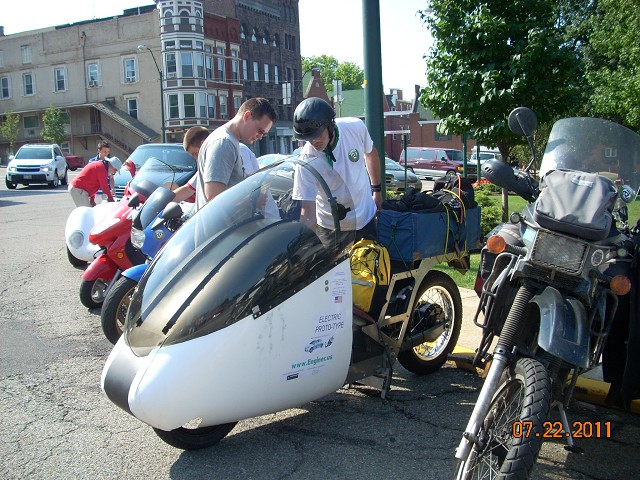 |
|
Electric Bikes Turn Back After 38 Miles - Only Ride 76 Miles Could you find a more patriotic group? - The electric bikes, each made in the USA were painted RED WHITE and BLUE. John Harding was riding a production Current Motor bike (Red). Kyle Ginaven riding his 1989 Suzuki Katana conversion (Blue). And Kraig Schultz rode the Schultz Engineering Delta-11 prototype bike (White). Each electric bike had the equivilent of less than .16 gallons of gasoline on board. Without full streamlining, we knew we could not complete the entire 104 mile course on one charge and so the electric motorcycle riders agreed to turn around at the Mt. Vernon snack stop to prevent possible damage to their battery packs by going "too far" and to avoid having to trailer the bikes back to Mid-Ohio. Before returning to Mid-Ohio, the electric riders stopped to eat lunch and recharge at a public park. We enjoyed our lunch break talking about our bikes, our families, the future, and with local people who were in the park. Due to power being shut off at the recharge location none of the electric bikes were fully recharged before returning to Mid-Ohio. Without a full charge we decided to ride back at reduced speed to conserve energy. All the bikes made it back to the starting point under their own power. Some people may think that stopping to recharge batteries during a trip is an inconvenience. I think that stopping to rest, recharge and visit with fellow riders and local people may be the most important change in our society since the invention of the automobile. The thing we have lost, we can find again - a connection with the natural rhythm of life and a social reconnection with people expedited by the appropriate, sustainable use of technology.  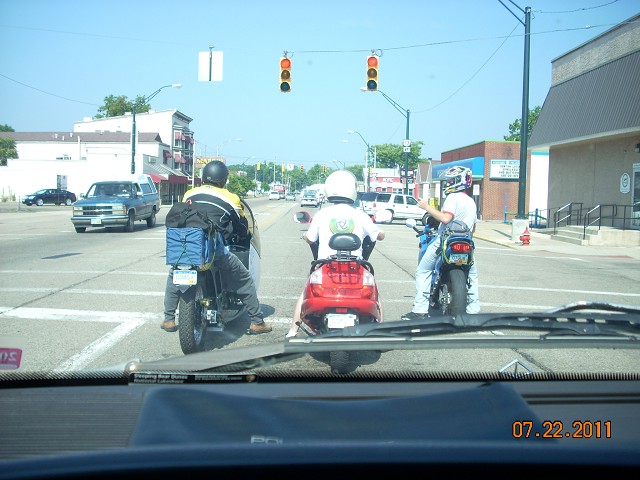 |
|
Pictures of Electric Bikes John Harding rode this production, red-colored Current Motor bike. 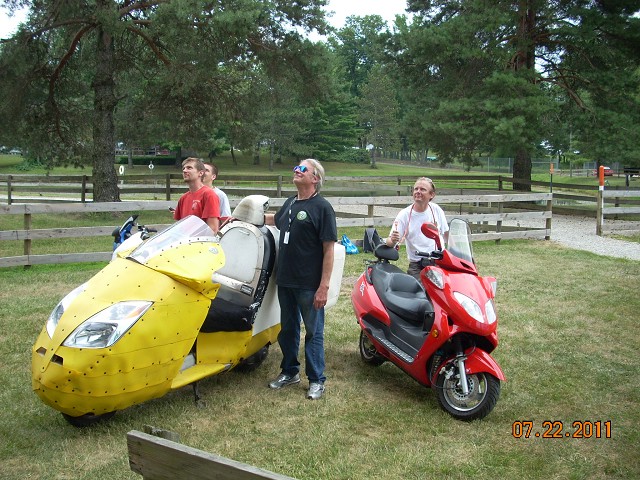 Kyle Ginaven rode his 1989 Suzuki Katana conversion.  Here is Maggie Schultz sitting in the Schultz Engineering Delta-11 prototype bike.  Craig Vetter declared a three-way tie for the electric bikes. Kraig Schultz accepts the Vetter Electric Vehicle trophy on behalf of the three Electric riders. 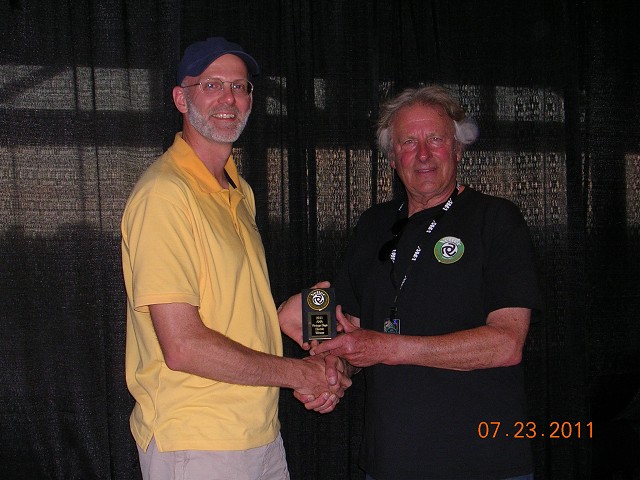 |
|
Pictures of Fossil Fuel Vehicles Charlie Perethian after the event  Charle Perethian's. son Max rode the winning bike (Morgan Vetter is standing behind it in this picture). 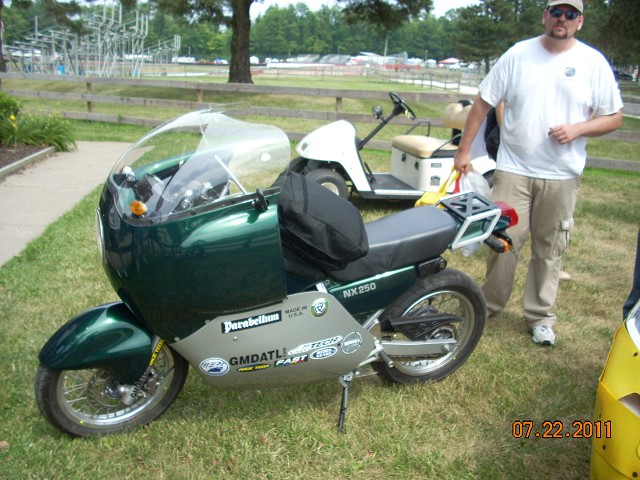 Fred Hayes Diesel Powered bike got second place. The Prius Hybrid with Enginer batteries is sitting next to Fred's bike.  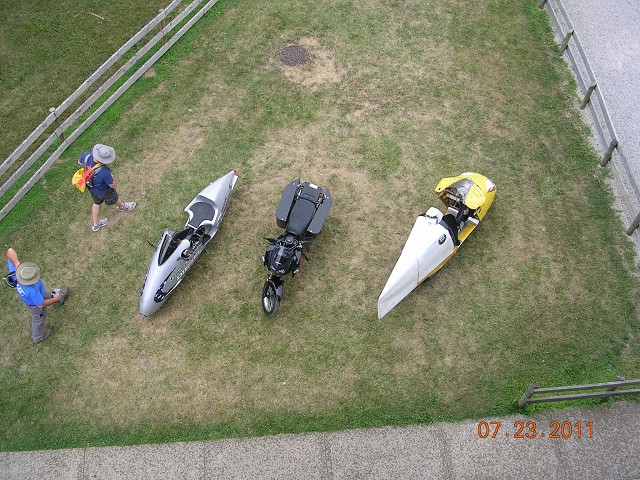 Ben Schloup rode this bike 600 miles in one day in from Michigans upper penisula for the event. He did very well until his rear tire blew out. 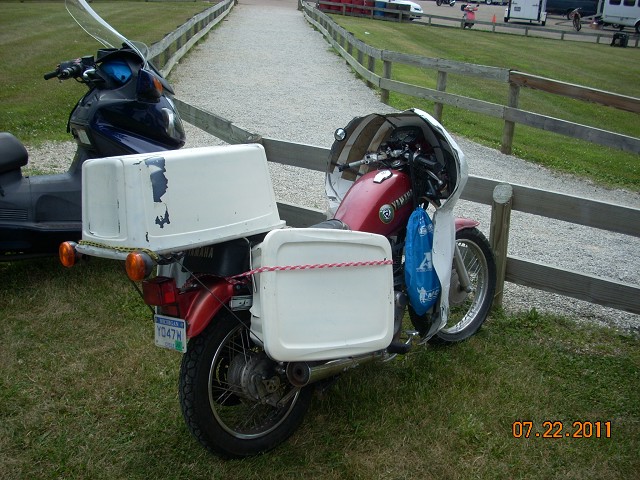 Jack McCornack Diesel car  Alan Smiths Bike that he rode across America to the event.  |
|
Recap of Vetter Fuel Economy Challenge July 22, 2011 I think the electric motorcycles made a good showing at the Challenge. We fired a warning shot across the bows of the fossil fuel bikes. If any of the electric bikes had had full streamlining they could have finished and "won" the event. As it is, the fossil bikes know we have the speed and power to ride with them and must get their acts together if they plan to win the event in the future. This year has been a year of missed opportunities for Schultz Engineering. In February, we identified rides and events we wanted to attend. We even made plans to ride to the events on the motorcycle. All this was planned based on the assumption that the Delta-11 bike would have a fully streamlined body on it. We hoped to "WIN" the Mid-Ohio event by completing the entire course. As it turned out, the streamlining is still not complete. It only has the front half done. So, our goal of achieving a 100 mile range at 55mph is still not accomplished. Going to Vetter Fuel Economy Challenge in Ohio, we knew we could not ride the full 110 miles at up to 65 miles/hour. The question was how far should we go before turning around? Should we we ride until the battery's are dead and get trailered back? Or should we turn around in time to not need trailering? How far can we go without risking damage to the battery's? Is "winning" the event worth risking damage to the battery's? In the end, the electric riders chose to let our batteries live to ride another day. (Next Page) |
|
Inventing a better tomorrow today... Copyright 2010-2011, Schultz Engineering, LLC |